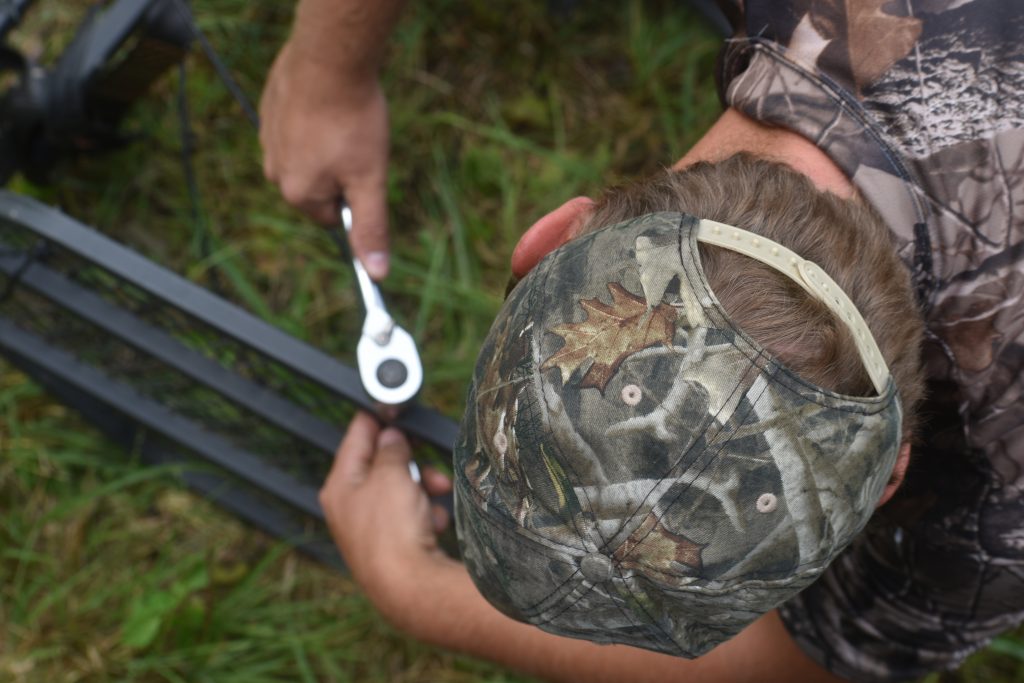Maintenance: It’s All Part of the Process
Keeping tools of the trade in tip-top shape is a must each hunting season.
The realization that hunting equipment does not run off adrenaline is often learned the hard way, such as a malfunction afield. Sure, gobbles and grunts keep us fired up, but they will not maintain our bows and tree stands. For this reason, equipment maintenance is key, especially in the world of bowhunting.
Tommy Floyd, president of the National Archery in the Schools Program, says maintenance is necessary for not only archery, but society.
“From something simple to a well-oiled machine, maintaining equipment is crucial,” he said. “Most of the equipment we use within youth archery revolves around the Genesis bow, which is easy to maintain. Maintenance includes keeping strings waxed, the bow clean, as well as bushings, cams and rollers free of debris. If these things are done and bows are checked often for breaks in the fibers, they’re dependable, accurate and great for youth.” Floyd said there are also other things to inspect on a regular basis.
“The arrows used are very important,” he said. “When practicing, check the positioning of your nock as well as the veins (or fletchings), making sure they’re still attached to the shaft.”
Floyd urged the importance of carefully inspecting a bow if it is ever dropped, adding, “After a fall, there’s often issues with the rest; always make sure it’s aligned properly with the riser.”
Last year, without any noticeable warning, a limb cracked on my crossbow while cocking it during a hunt. Disappointed, I borrowed my dad’s crossbow while mine was being repaired. Instead of going hunting on the next opportunity, I decided to spend the morning shooting the bow; after all, it had just taken a ride in my truck. The bow was shooting slightly to the left, not much, but enough to turn a lethal shot into a sore shoulder. After spending a couple of hours tweaking and adjusting the issue, I decided to hunt that evening. Although I was late getting afield, I harvested a nice 10-pointer.

Takeaway? With archery (compound or crossbow), frustration and the testing of patience is inevitable. However, taking the time to do the little things, such as shooting a borrowed bow before hunting, can change the overall result.
Blaine DePoy, owner of Blaine’s Guns and Bows, has been maintaining bows for nearly three decades and said bow maintenance is even more critical when youth are involved, and not solely due to safety.
“Kids grow so fast during that 10-12 age range that they outgrow their bow, quickly,” he said. “Kids don’t realize that they are growing, but the bow is staying the same. They will instinctively keep adjusting their body to try to make it work, and suddenly, they’re bent over trying to shoot. When the wheels cam over (go beyond the natural stopping point), you know a kid is overextending that bow. It may even be a monthly adjustment during that age range.”
On a good note, DePoy said modern bows make the adjustment much easier for everyone involved.
“Most modern-day bows have a setting on the cam that can be adjusted by simply knowing your ABCs,” he said. “They are usually in ½-inch to 1-inch increments, and as the kid grows, you grow the bow with them. Bows are versatile now; some adjusting from an 11- to a 29-inch draw length, which is unheard of. Also, as that draw length goes farther back, the kisser and peep sight must change.”
Tree Stand Maintenance
Tree stands (both ladders and lock-ons) are useful during all parts of the deer season. However, as useful as they are, they too require maintenance.
As trees grow, the straps holding your stand to the tree begins to rot and wear out. It’s not advisable to leave a ladder or lock-on stand up throughout the year – better to take it down after the season and replace worn ratchet straps annually as needed.
In addition, check all the bolts on the stand assembly itself, especially those connecting the cable from the seat to the foot platform, as one’s support is critical to the others’ performance. Additionally, never climb a tree without a safety harness, because when all else fails, it can be your lifeline.

Treat your bow, firearm and hunting stands with respect. They’re tools and are as vital to the process as you and the animal are. If you do so, one day you may have the privilege of handing them down to another youngster, while preaching the importance of maintenance yourself. If you’ve done your job, you will have the weathered, yet reliable equipment, to prove your point.
